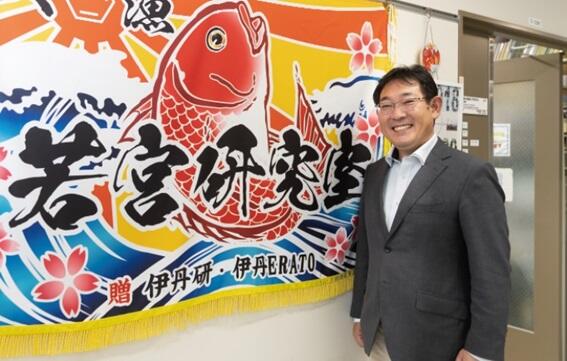Next-generation lightweight and flexible perovskite-based solar cells can be readily manufactured using low-temperature processes. Despite their notable performance, environmental and human health concerns regarding the use of lead (Pb) in these devices are driving an intense search for Pb-free alternative materials. For insights about the recent advances and future directions in this endeavor, JST News conducted an interview with Professor Atsushi Wakamiya of the Institute for Chemical Research (ICR) at Kyoto University. Prof. Wakamiya has garnered international recognition for his pioneering efforts in the field of perovskite solar cells.
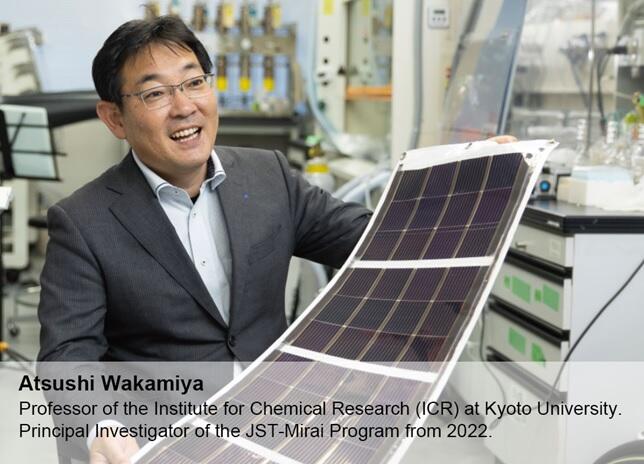
Low-cost, lightweight, and flexible devices for building integrated photovoltaics
Solar cells are garnering increasing attention as a means to address the energy challenges in contemporary society. In 2021, the introduction of a feed-in tariff system for renewable energy precipitated the widespread adoption of silicon-based solar cells. Despite Japan's distinction as a leading nation in terms of solar cell area density, the total contribution from renewable energy sources is still insufficient to achieve carbon neutrality.
The scarcity of suitable terrain for the installation of solar panels in Japan has driven a recent surge in interest in perovskite solar cells designed for installation on rooftops and walls.
Silicon-based solar cells currently dominate the photovoltaic market, offering customers high efficiency and good durability. The material and manufacturing costs are relatively high, however. The active layers of perovskite solar cells, on the other hand, can be produced by depositing materials with a total thickness 1/100th the diameter of a human hair onto a thin, flexible plastic film. Lightweight and flexible structures are possible, concomitant with a reduction in manufacturing expenses. The impressive power generation efficiency of perovskite solar cells, retained even in low-light conditions such as indoor or ambient lighting, make this renewable energy technology suitable for a myriad of applications and locales (Fig. 1).
Fig. 1: A comparison of silicon solar cells with perovskite solar cells
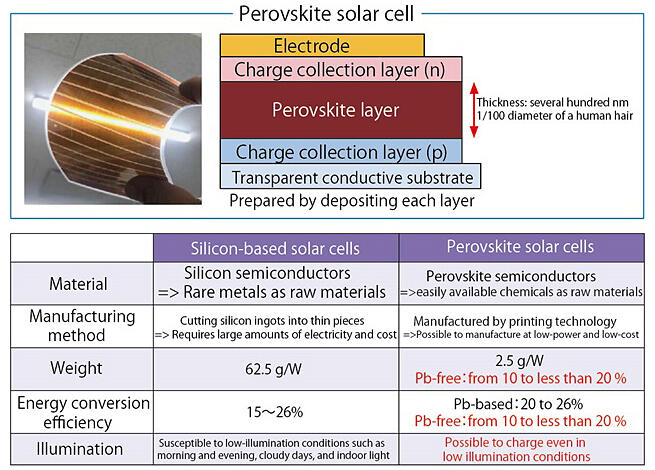
Before perovskite solar cells can find widespread practical application, several challenges must be addressed. As the perovskite materials typically contain lead (Pb), they are subject to regulatory oversight pursuant to the Restriction of the Use of Certain Hazardous Substances (RoHS) Directive. In order to facilitate the widespread adoption of perovskite solar cells while minimizing environmental and health implications, the performance of perovskite solar cells using Pb-free materials needs to be improved. Prof. Wakamiya of the Institute for Chemical Research (ICR) at Kyoto University is a dedicated advocate of this important goal.
Aspiring to contribute through embarking on research that instils a sense of pride
Prof. Wakamiya recalls, "When I was in my first year of high school, I read an article in a science magazine that said 'scenery can be explained by the wavelength of light.' I was deeply impressed that scientific language could explain the phenomena around us. Starting from the following day, the landscape I beheld underwent a profound transformation." With this event as a trigger, he aimed to be a researcher and entered the Faculty of Engineering at Kyoto University. After graduating from the University, he studied at the Department of Energy and Hydrocarbon Chemistry of the Graduate School of Engineering at Kyoto University. Since 2003, he served as a Research Assistant and Assistant Professor of the Graduate School of Science at Nagoya University.
In 2010, he made the pivotal decision to rejoin Kyoto University, and it was during this juncture that he encountered a pivotal turning point, ultimately propelling him to his current role. This transition unfolded as he wholeheartedly engaged in fundamental research, assuming the position of an associate professor at ICR.
"As I envisioned my retirement at the age of 65 and contemplated the ensuing three decades of my life dedicated to research, my aspiration was to immerse myself in research endeavors that would evoke a profound sense of pride, knowing that my contributions were meaningful to both humanity and society as a whole." The theme that came to his mind was the issue of energy. After a profound contemplation of how he, as a scientist equipped with expertise in molecular and material design, could make a meaningful contribution to the field of energy, he found his answer in the realm of solar cells.
He embarked on his journey toward dedicated research when he was selected to participate in the JST's PRESTO program "Photoenergy conversion systems and materials for the next generation solar cells". It was during this period that Wakamiya encountered the potential of perovskites, a material that was relatively obscure at the time. Driven by this potential, he made the decision to focus his research on perovskite. Subsequently, he assumed the role of principal investigator for two initiatives: 'film-type solar cells' under the Center of Innovation (COI) program, and 'development of high-performance perovskite solar cells with low environmental impact' as part of the Advanced Low Carbon Technology Research and Development Program (ALCA). Beginning in April 2022, his involvement in exploratory research within the 'Pb-free Perovskite Solar Cells Consisting of Sn' project of JST-Mirai Program further cemented his dedication to advancing the performance of perovskite solar cells.
Pb-free perovskite solar cell research has gained substantial global attention, with notable advances being made in the realm of tin (Sn)-based perovskite materials. Compared to conventional Pb-based materials, the power conversion efficiency of Sn-based alternatives has remained below the necessary targets for commercial viability. Prof. Wakamiya has achieved a series of world-leading results enhancing the performance of Sn-based perovskite semiconductors and solar cells.
High efficiency is achieved by new and original materials and manufacturing methods
A pivotal facet of the quest for improved performance revolves around enhancing the quality of materials used to make the devices. The divalent Sn ions (Sn2+) in tin-based perovskites are susceptible to oxidation, producing tetravalent Sn ions (Sn4+). These Sn4+ impurities have a detrimental effect on the electronic properties of the perovskite, and the solar cell becomes less efficient as a result. Developing methods to improve the purity of the material has therefore been prioritized. As Prof. Wakamiya notes, "We have successfully engineered a material in which residual Sn4+ impurities were entirely eradicated from tin iodide (SnI2), a starting material traditionally used to fabricate tin-based perovskites."
Furthermore, in 2020, a significant revelation surfaced concerning the presence of extremely small amounts of oxygen in both the solvent and the fabrication environment. It was the reaction with this oxygen that resulted in the generation of Sn4+ species. In response, a scavenger method was developed where zero-valent Sn0 nanoparticles are produced immediately before perovskite film fabrication, effectively consuming Sn4+ species via reduction with the metallic tin nanoparticles. As a result, the efficiency of the Sn-based perovskite solar cells was improved, reaching 11.5% (see Fig. 2).
Fig. 2: Scavenging Sn4+ with Sn0 nanoparticles
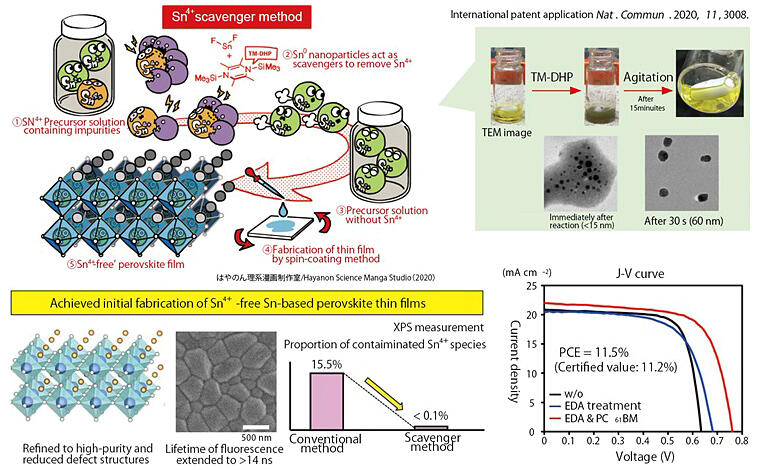
To increase the solar cell efficiency, researchers in Prof. Wakamiya's laboratory have devised a proprietary deposition technique for perovskite semiconductor films. The objective is to generate a uniformly aligned crystalline film that seamlessly covers the substrate. It was observed that the nucleation of crystals in the Sn-based perovskite semiconductor proceeded at a slower pace compared to its Pb-based counterpart. Once initiated, however, the subsequent growth of these crystals occurred at a rapid rate and often failed to fully coat the substrate (Fig. 3).
Fig. 3: Proprietary fabrication technique for high-quality Sn-based perovskite thin films
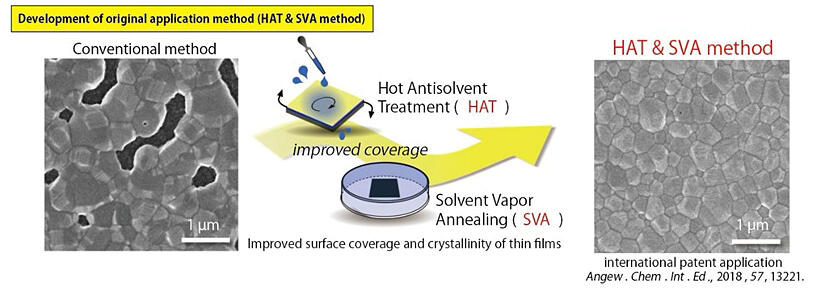
Introducing a poor solvent during deposition encourages the formation of crystal nuclei. From that basis, Prof. Wakamiya hypothesized that rapid mixing would increase number density of the crystal nuclei. "This insight led to the conception of the Hot Antisolvent Treatment (HAT), where chlorobenzene, a poor solvent, is heated before it is applied to the substrate. The most uniform film was achieved when chlorobenzene was heated to 65 ℃." Subsequently, uniform films with larger crystalline domains was successfully realized through the 'Solvent Vapor Annealing (SVA) method,' where the solvent's vapor pressure was controlled during the heating step.
Prof. Wakamiya has continued to tackle these challenges and achieved numerous accomplishments. In April 2022, to maximize the photoelectric conversion efficiency of perovskite solar cells, he developed a novel 'passivation method' that precisely controls the surface structure to improve the efficiency of charge extraction from the perovskite layer. He succeeded in reducing the voltage loss to the theoretical limit and achieved a photoelectric conversion efficiency of 23.6%, the highest value in the world for perovskite solar cells, including Sn-based perovskite solar cells (Fig. 4 and Fig. 5).
Fig. 4: Structural modification (passivation) method for the upper and lower surfaces of perovskite thin films
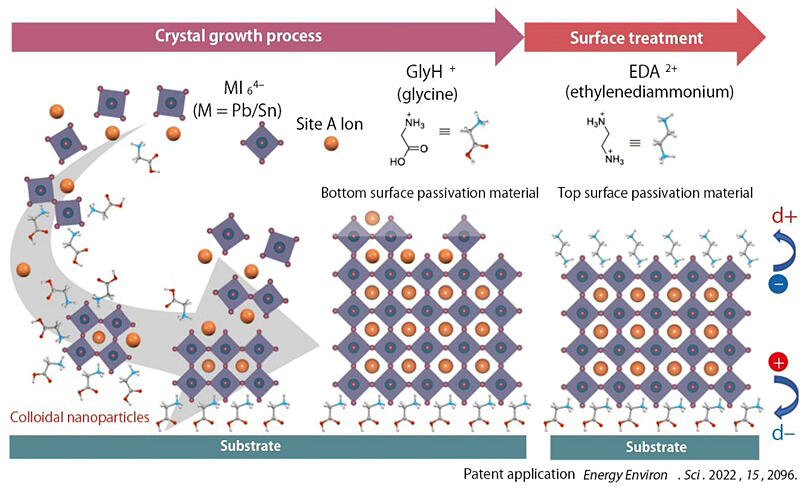
Fig. 5: Improvement of photoelectric conversion efficiency of Sn-Pb mixed perovskite solar cells fabricated by the passivation method
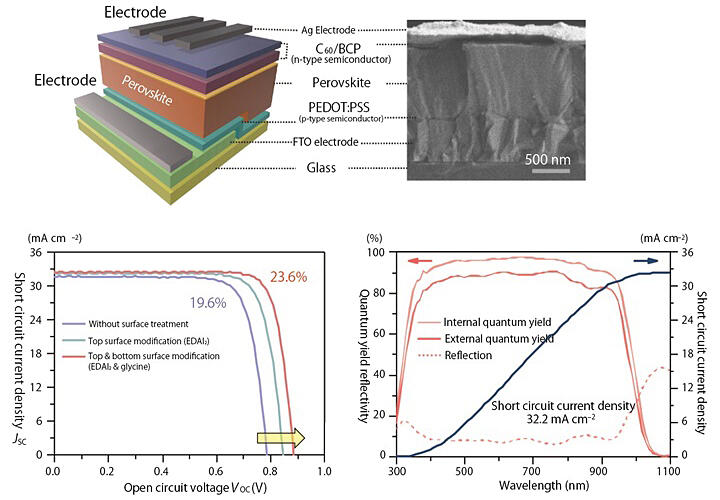
It was found that the photoelectric conversion efficiency improved to 23.6% (short circuit current density of 32.1 mAcm-2, open circuit voltage of 0.89 V) by passivating the upper surface with ethylenediammonium and the lower surface with glycine (bottom).
In December of the same year, a breakthrough was achieved with the development of 'phosphonic acid-functionalized triazatruxene (PATAT),' a tripodal hole collecting monomolecular material poised to substantially elevate the performance of perovskite solar cells. Perovskite solar cells using this material achieved a photoelectric conversion efficiency of 23%. It is highly durable, maintaining 90% output even after 2,000 h in a nitrogen-gas atmosphere and 450 h in air.
A startup company with a view to developing portable, off-grid solar power stations
In parallel with his R&D, in January 2018, Prof. Wakamiya founded the startup company EneCoat Technologies Co., Ltd. "The inception of the startup company was motivated by my earnest desire to globally advance the technology of perovskite solar cells accelerate their practical implementation," Prof. Wakayama recalls. The company's greatest strength lies in its ability to swiftly incorporate research results into new materials to manufacturing equipment.
The potential applications for off-grid portable power stations is facilitated by the versatility of perovskite solar cells, which are virtually boundless. These cells, characterized by their lightweight, flexible nature and capacity to generate power even in low-illumination conditions, open doors to a multitude of possibilities. They can find utility in various domains, including smartphones and wearable devices, IoT sensors, vehicles, and drones (Fig. 6). Prof. Wakamiya says, "We have received particularly positive responses regarding a prototype of a power generation disaster tent that we developed. The integration of multiple perovskite solar cells into these tents at evacuation centers, connected to smartphones, enables the simultaneous charging of dozens of smartphones. This innovation provides a critical lifeline during power outages triggered by disasters, encapsulating my vision."
Fig. 6: Social implementation of perovskite solar cells aimed at by this research
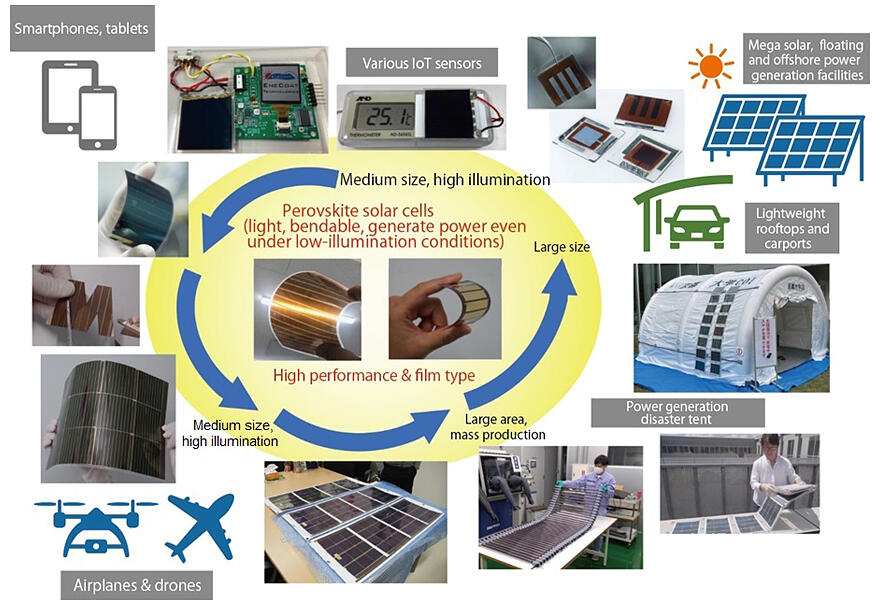
Furthermore, to accelerate the practical application of film-based solar cells, mainly perovskite solar cells, the 'Film Photovoltaic Research Consortium' was established in 2020 through industry-academia collaboration. This collaborative initiative boasts the active participation of thirty companies, encompassing material manufacturers and device producers. Together, they are advancing a range of endeavors including technical collaboration and standardization efforts, geared towards facilitating the rapid commercial rollout of perovskite solar cells (see Fig. 7).
Fig. 7: Film Photovoltaic Research Consortium
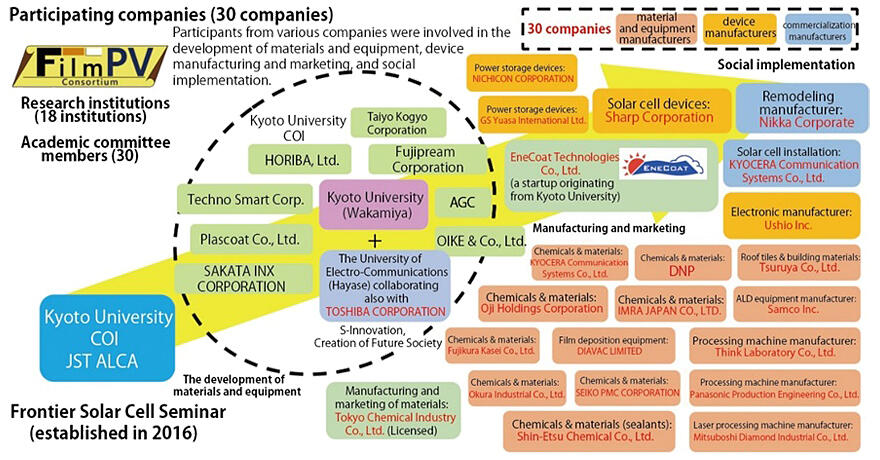
The global imperative for carbon neutrality has provided substantial momentum, fostering high hopes for the practical implementation of Pb-free solar cells. However, it is crucial to acknowledge that several hurdles must still be surmounted. Prof. Wakamiya underscores the necessity of approaching these challenges with a discerning eye, emphasizing the need to identify the core issues rather than merely relying on surface-level modifications. His vision is one of fundamental enhancements.
Simultaneously, Wakamiya, with enthusiasm evident in his gaze, shares his audacious dream: "Imagine if we were to deploy solar panels similar to rafts on the high seas, where rainfall is scarce and the weather is relatively stable, and then share the power generated by these solar panels across the world. Could this be a path to global peace?" Wakamiya, renowned as a 'people-charmer' in his own right, remains unwavering in his commitment to collaborate with fellow researchers in the quest to implement perovskite solar cells into society. His future endeavors hold our unwavering attention.
(Article: Hidemi Sasou, Photography: Hideki Ishihara)
